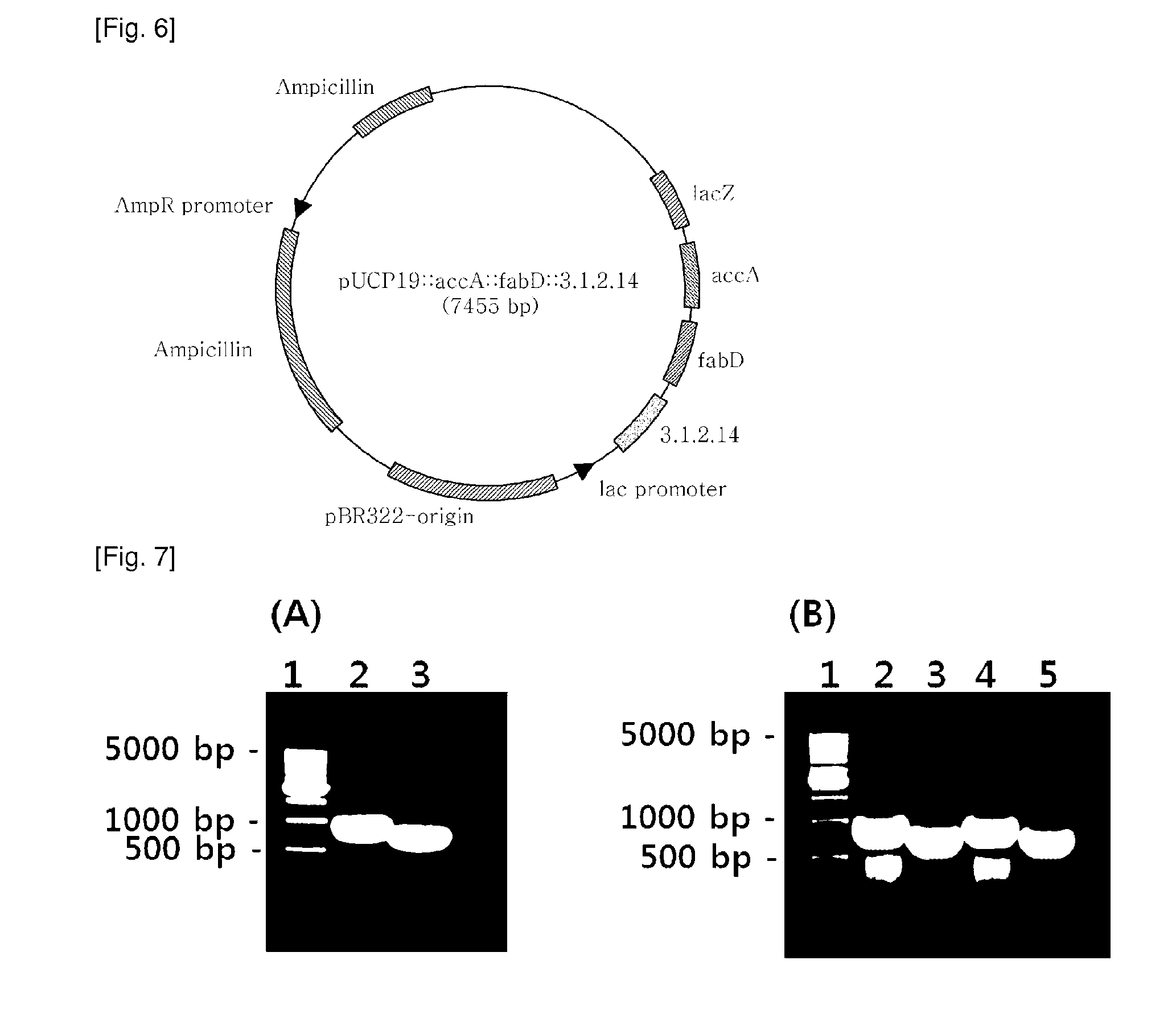Pseudomonas aeruginosa strain developed for improving fatty acid content, and method of manufacturing the same
a technology of fatty acid content and recombinant pseudomonas aeruginosa, which is applied in the direction of transferases, applications, ligases, etc., can solve the problems of serious environmental crisis affecting mankind, and not much research has been conducted into the effect of exogenous genes from other species, so as to achieve high yield and modify the metabolism flow
- Summary
- Abstract
- Description
- Claims
- Application Information
AI Technical Summary
Benefits of technology
Problems solved by technology
Method used
Image
Examples
example 1
EXAMPLE 1
[0080]Construction of Recombinant Plasmids Carrying accA and fabD Genes and Carrying 3.1.2.14 Gene Using Polymerase Chain Reaction (PCR)
[0081]Nucleotide sequences of accA and fabD (GenBank, NCBI), which encode enzymes responsible for the production of malonyl-CoA and malonyl-CoA:ACP, respectively, were amplified by PCR (DaKaRa, Korea) using primers with the genomic DNA of Pseudomonas aeruginosa PAO1(KCCM) serving as a template. Separately, PCR was performed on the genomic DNA of Streptococcus pyogenes MGAS10270 (ATCC) in the presence of primers suitable for amplifying a gene encoding acyl-acyl carrier protein thioesterase (E.0 3.1.2.14) (GenBank, NCBI), which is new to Pseudomonas aeruginosa (Tables 1 and 2).
TABLE 1GeneEnzymeaccAacetyl-CoA carboxylase, carboxytransferase,alpha subunitfabDmalonyl-CoA-[acyl-carrier-protein]transacylase3.1.2.14acyl-acyl carrier protein thioesterase
TABLE 2SEQIDRestrictionGenePrimer SequenceNO:EnzymeaccAF5′-TCTAGACGACGGAAGCCTATGAACCCG-3′ 8XbaIR...
example 2
[0083]Construction of Recombinant Plasmids pJSO4 and pJS07
[0084]pGEM-T::3.1.2.14, pGEM-T:accA, and pGEM-T:fabD, recombinant plasmids of Example 1, and pUCP19 (ATCC, FIG. 2), a shuttle vector for both E. coli and Pseudomonas, were separately treated for 2 hrs with the restriction enzymes of Table 2 in a 37° C. water bath. The resulting DNA digests were inserted into the multi-cloning site of pUCP19, as shown in FIGS. 3 to 5, by ligation at 16° C. using T4 ligase (Dakara). The cloning of each of the genes was examined upon every insertion. After transformation into E. coli (AG1 competent cell, Stratagene), the recombinant plasmid was isolated and digested with the same restriction enzymes as were used for insertion, and the size of the DNA digest was determined on 0.8% agarose gel by electrophoresis.
[0085]After digestion with the restriction enzymes of Table 2, the PCR products were introduced into pUCP19 to afford recombinant plasmids pJSO4 (carrying the 3.1.2.14 gene) (FIG. 3), pJS0...
example 3
[0086]Preparation of Pseudomonas aeruginosa Transformant
[0087]In consideration of the stability and efficiency of transformation, electroporation was used.
[0088]Before electroporation, wild-type Pseudomonas aeruginosa PA14PA14 (ATCC, GenBank NC—008463, Julia M. Plotnikova, et al., Plant Physiol, December 2000, Vol. 124, pp. 1766-1774; Nicole T. Liberati et al., PNAS 103(8):2833-2838(2006)) was pre-cultured for 16 hrs and 30 pl (0.1%) of the culture was inoculated into 3 mL of LB (10 g / L tryptone, 10 g / L NaCl, 5 g / L yeast extract) and centrifuged to separate cells (12,000 rpm, 1 min) and the medium when absorbance at 600 nm reached 0.6. Then, the cells were washed once with 1 mL of 10% glycerol and harvested by centrifugation (12,000 rpm, 1 min). The cell pellet was resuspended in 80 μL of 10% glycerol. To the suspension was added 1 μL of the recombinant plasmids (pJSO4, pJS05, pJS06, and pJS07). The mixtures, each totaling about 80 μl, were placed in respective cuvettes for electrop...
PUM
| Property | Measurement | Unit |
|---|---|---|
| pH | aaaaa | aaaaa |
| temperature | aaaaa | aaaaa |
| thickness | aaaaa | aaaaa |
Abstract
Description
Claims
Application Information
 Login to View More
Login to View More - R&D
- Intellectual Property
- Life Sciences
- Materials
- Tech Scout
- Unparalleled Data Quality
- Higher Quality Content
- 60% Fewer Hallucinations
Browse by: Latest US Patents, China's latest patents, Technical Efficacy Thesaurus, Application Domain, Technology Topic, Popular Technical Reports.
© 2025 PatSnap. All rights reserved.Legal|Privacy policy|Modern Slavery Act Transparency Statement|Sitemap|About US| Contact US: help@patsnap.com



